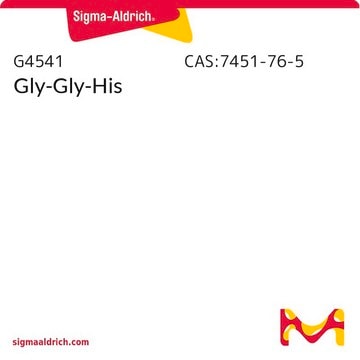C0166
Cys-Gly
≥85% (TLC), suitable fo HPLC
Synonym(s):
L-cysteinyl-glycine
Sign Into View Organizational & Contract Pricing
All Photos(1)
About This Item
Empirical Formula (Hill Notation):
C5H10N2O3S
CAS Number:
Molecular Weight:
178.21
MDL number:
UNSPSC Code:
12352209
PubChem Substance ID:
NACRES:
NA.26
Recommended Products
Product Name
Cys-Gly, ≥85% (TLC)
Quality Level
Assay
≥85% (TLC)
form
solid
technique(s)
HPLC: suitable
storage temp.
−20°C
SMILES string
NC(CS)C(=O)NCC(O)=O
InChI
1S/C5H10N2O3S/c6-3(2-11)5(10)7-1-4(8)9/h3,11H,1-2,6H2,(H,7,10)(H,8,9)
InChI key
ZUKPVRWZDMRIEO-UHFFFAOYSA-N
Looking for similar products? Visit Product Comparison Guide
Related Categories
General description
Cys-Gly, a dipeptide is a catabolic byproduct of glutathione.
Application
Cys-Gly has been used for derivatization by p-hydroxymercury benzoate (PHMB) for calibration of reversed phase chromatography coupled on-line and sequentially with a UV−visible diode array detector (RPLC-DAD).
Biochem/physiol Actions
Cys-Gly is a precursor for glutathione biosynthesis in the neurons. It favors reactive oxygen species generation in the presence of transition metal ions. A normal level of cys-gly is essential for normal cellular function.
L-Cysteine-L-Glycine (Cys-Gly) is used in studies on the homeostasis of glutathione. Cys-Gly is an important molecule for study in the areas of thiol homeostasis, oxidative stress and metals management.
Other Notes
Glutathione fragment
Signal Word
Warning
Hazard Statements
Precautionary Statements
Hazard Classifications
Acute Tox. 4 Oral - Eye Irrit. 2
Storage Class Code
11 - Combustible Solids
WGK
WGK 3
Flash Point(F)
Not applicable
Flash Point(C)
Not applicable
Personal Protective Equipment
dust mask type N95 (US), Eyeshields, Gloves
Choose from one of the most recent versions:
Already Own This Product?
Find documentation for the products that you have recently purchased in the Document Library.
Customers Also Viewed
Dagmar Drogan et al.
Arteriosclerosis, thrombosis, and vascular biology, 30(10), 2053-2058 (2010-07-31)
To investigate the interrelation between plasma γ-glutamyltransferase (GGT) activity, cysteinyl-glycine (Cys-Gly) (ie, a thiol originating from GGT-mediated cleavage of glutathione), and oxidized low-density lipoprotein (oxLDL) with regard to myocardial infarction (MI) risk in a prospective study. Incident cases of MI
Sandra Osburn et al.
Journal of the American Society for Mass Spectrometry, 23(6), 1019-1023 (2012-03-01)
The radical cations of Cys-Gly and Gly-Cys were studied using ion-molecule reactions (IMR), infrared multiple-photon dissociation (IRMPD) spectroscopy, and density functional theory (DFT) calculations. Homolytic cleavage of the S-NO bond of nitrosylated precursors generated radical cations with the radical site
Purification and characterization of a Cys-Gly hydrolase from the gastropod mollusk, Patella caerulea
Cappiello M, et al.
Journal of Enzyme Inhibition and Medicinal Chemistry, 31(6), 1560-1565 (2016)
Pawinee Panpetch et al.
BMC plant biology, 21(1), 69-69 (2021-02-03)
Durian (Durio zibethinus L.) is a highly popular fruit in Thailand and several other Southeast Asian countries. It is abundant in essential nutrients and sulphur-containing compounds such as glutathione (GSH) and γ-glutamylcysteine (γ-EC). Cysteinylglycine (Cys-Gly) is produced by GSH catabolism
Emilia Bramanti et al.
Talanta, 74(4), 936-943 (2008-03-29)
We report on the application of a commercially available mercury analyzer, which is based on vapour generation of Hg(0) by NaBH(4) reduction and atomic absorption detection, to the quantification and characterization of -SH groups and its application to wine samples.
Our team of scientists has experience in all areas of research including Life Science, Material Science, Chemical Synthesis, Chromatography, Analytical and many others.
Contact Technical Service










